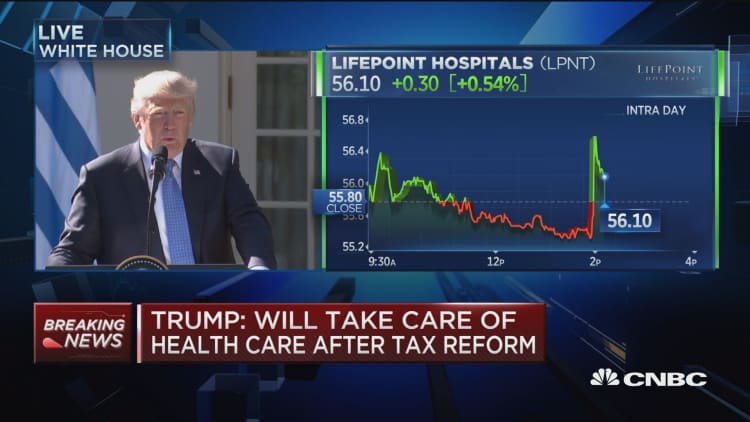
President Donald Trump is seriously considering a candidate for Fed chair whose academic work suggests that interest rates could be nearly triple where they are now.
Stanford economist John Taylor is known for his Taylor Rule, an economic gauge that dictates where the Fed's benchmark funds rate should be, given prevailing conditions. The rule suggests that the current rate should be around 3 percent, rather than the current 1.15 percent level.
That's the easy conclusion. The reality is more complicated.
Taylor's real allure to Trump could be that he shares the president's belief that the economy can perform more strongly than it is now. To that end, he makes himself a more attractive choice than some of the other candidates who subscribe more to the current consensus that growth will be mired around 2 percent for years to come.
"To the extent that the Taylor Rule is built on an assumption about potential GDP, John will be much more willing than some of the other candidates to allow the economy to run at a much faster rate," said Joe LaVorgna, chief economist for the Americas at Natixis.
LaVorgna sees Taylor as a strong pick who believes the economy can outperform "because of the benefits of deregulation and the possibility of tax cuts and lower marginal rates on business profits and accelerated depreciation, things of that sort."
That kind of thinking would check off some key boxes with Trump. The president anticipates that his agenda of lower taxes, less regulation and aggressive infrastructure spending would generate growth of more than 3 percent, compared with the 2.1 percent postrecession rate at which it had been moving.
Where the Trump-Taylor connection could break, though, is the view on interest rates.
The president repeatedly has said he'd like the Fed to keep rates low, as it has done since the days of the financial crisis when the funds rate was brought down to near-zero. The Taylor Rule, though, theoretically would call for substantially higher rates. Taylor also might push for a faster rolloff of the Fed's $4.5 trillion balance sheet and is in favor of a single mandate focusing solely on price stability, rather than the current dual mandate that also seeks to foster full employment.
Taylor and the White House did not return a request for comment. Trump has indicated he will pick a chair in the coming weeks, probably by Nov. 3.
The Atlanta Fed has a tool for calculating the Taylor rate that allows for choosing different inputs. The funds level is used as a gauge for a host of other consumer rates and is tied directly to the prime rate that lenders use to calculate interest they charge.
Using the default levels for the inflation target, the natural real rate, resource gap and the preferred inflation gauge, the Taylor rate now would be 2.94 percent, well above the current 1.15 percent level (targeted between 1 percent and 1.25 percent).
While on its face that would indicate that Taylor is an unlikely nominee to succeed current Chair Janet Yellen, Fed watchers see more to the story.
"A Taylor Fed may not follow the Taylor rule; as Yellen has shown, there's often a lot of daylight between a given Chair's preferences and actual policy in the modern Fed, and a Fed chair can have a hard time being imperial," Bespoke Investment Group's Paul Hickey said in a note.
"Even if the Fed did switch to a Taylor rule-based policy, small changes to the various inputs can create radically different recommended rates," he added. "If we do get a Taylor Fed, there's plenty of room for Fed policy to be tighter or looser. Taylor's history suggests he's more likely to be a hawk versus the current baseline, but from where we sit, there's an awfully cloudy view of what happens next assuming Taylor is appointed."
To be sure, Taylor has no easy path to the top seat at the U.S. central bank.
He's up against at least four other candidates: Yellen, current Fed Governor and presumed front-runner Jerome "Jay" Powell, former Fed Governor Kevin Warsh and Trump's top economic advisor Gary Cohn.
However, his candidacy shouldn't be dismissed simply because of a presumption that he would push for higher rates.
"Taylor's rule would still point to a low federal funds rate by past standards, especially if the rule were tweaked to allow for the fact that the 'neutral' level of the rate has fallen," wrote John Higgins, chief market economist at Capital Economics, referring to the point that is neither stimulative nor restrictive regarding growth.
That Trump is seriously considering Taylor is indicative that there's likely room to fudge the Taylor Rule.
"You could make some very realistic assumptions using the Taylor Rule approach that do not put the funds rate much higher than where it is at the moment," LaVorgna said. "Taylor coming on board could very much be someone who is not anywhere near as hawkish as the market believes."
WATCH: Evaluating the five front-runners for the Fed job.



